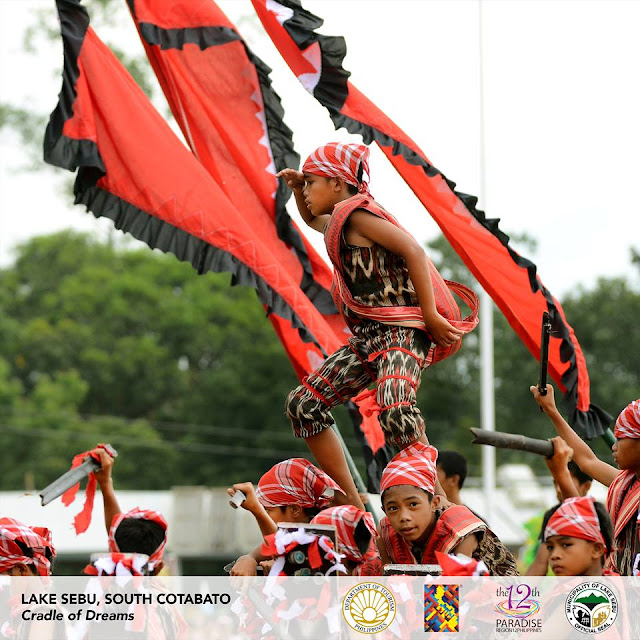My Lake Sebu
This simple gono bong (house) showcases artifacts and memorabilia such as native crafts like woodcarved items and t’nalak, but also some of the local T’boli brass instruments visitors can try out. It’s great that such a place of cultural learning exists for both the younger generations of T’boli, and visitors to the area.
The Tboli Museum
Be sure to keep the area clean and as undisturbed as possible, if ever you decide to come for a visit.
The Majestic Three Kings in Lake Sebu
Here are a few helpful hints: It is an endangered animal, its species is usually referred to as a king, and its original name indicates the animal that was initially thought of as its only diet.
We think these clues are more than enough to help you figure this one out. Good luck!
Guess what Philippine symbol can be found in the forests of LakeSebu?
This meeting of the rivers eventually formed a lake–what people now recognize as a Lake Seloton–originally 75 hectares big, though over the years it has grown to become only 48 hectares.
Lake Seloton in Lake Sebu
Among the 12 islets located on Sebu Lake is Tegaya Island, recognized by the locals for its history. The island was once a burial ground of the T’boli, though it is no longer in use for this purpose.
Tegaya Island in Lake Sebu
Join the Helobung Festival, a celebration of the T’boli culture, held during the second week of the month. The festival includes a traditional chanting and dancing activities, and a boat racing competition that takes place on the 354-hectare lake.
We promise you, this trip is going to be one heck of a celebration. Can’t wait to see you guys till then!
We promise you, this trip is going to be one heck of a celebration. Can’t wait to see you guys till then!
Lake Sebu celebrates Helobung Festival every November
They are well taken care of animals that help with farming and with travel, especially to places not accessible by motorized vehicles.
Horses are of so much value to the T’bolis that years ago, high quality t’nalak was used to barter for them!
Horses are of so much value to the T’bolis that years ago, high quality t’nalak was used to barter for them!
Did you know that horses are highly-valued by the tribes of Lake Sebu?
For example: Before they would cut a tree or get water from the lake, the T’boli’s ask permission and give offerings, called densu, to appease the spirits.They also pray to the gods of the moon, sun, and stars, for a healthy life or safe travel.
Did you know that spirituality is a big part of the lives of the T’boli?
Did you know that dreamweaving is not a hereditary gift?
On Weaving Tnalak
Here are some of the materials the T’boli use for sourcing their colors: The roots of a loko plant is used for the color red, k’luga (annatto) for orange, lomus leaves for the color green, bayabas for the color brown, and luyang-dilaw (turmeric) for yellow.
Tboli women's colorful costumes
No wonder it takes up to 3-4 months to completely finish one beautiful roll of t’nalak cloth.
T'nalak Weaving
You’ve heard of parades, but have you ever seen a Grand Parade? Celebrating the three main groups of South Cotabato, the T’nalak Festival’s Grand Parade showcases a variety of T’nalak designs, dances, and performances by various groups, communities, and even schools, throughout the province. It’s a parade unlike any other you’ve seen before!
Be amazed as you see people from all over South Cotabato and neighboring provinces come together to celebrate at this exhilarating month-long extravaganza.
T'nalak Festival Grand Parade happens every July 18
Stories are pieces that showcase history and creativity, but at the T’nalak Festival, these stories find new life through reenactments. Enjoy performances by various groups through ADUSAY (Awit, Dula, at Sayaw), consisting of differently-themed performances that portray these tales through songs, dances, and drama interpretation.
We can’t wait to show you how we tell our stories. See you at this year’s upcoming T’nalak Festival!
We can’t wait to show you how we tell our stories. See you at this year’s upcoming T’nalak Festival!
See you in South Cotabato this July for T'nalak Festival!
It’s one of the most beautiful things to see, especially if you want to see how the T’boli’s celebrate their culture and heritage. Book your ticket now, July is just around the corner!
T'nalak Festival in South Cotabato
Mag-subscribe sa:
Mga Komento
(
Atom
)
© My Lake Sebu 2013 . Powered by Blogger . Blogger templates . New Blogger Templates Published..Gooyaabi Templates














